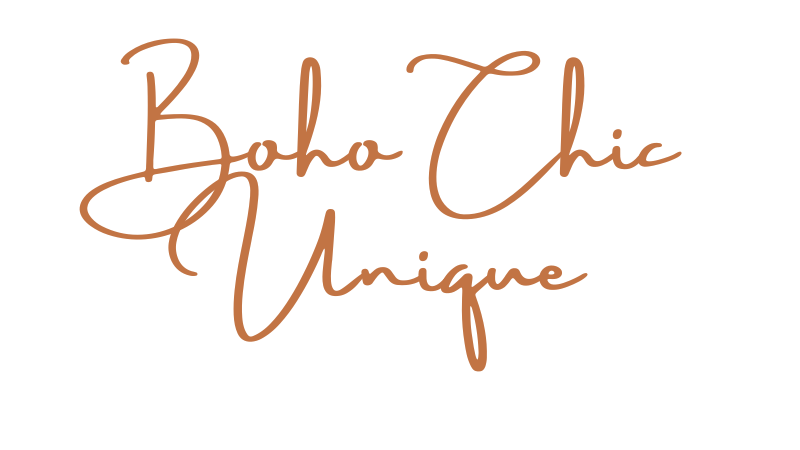
Dream Catcher: When Spiritual Protection become Decor
In a world where mindfulness and holistic living are increasingly valued, the dream catcher is valued as both a symbol of spiritual protection and as a boho decor accent.
The dream catcher is believed to offer spiritual protection by filtering out negative energies and nightmares while allowing positive dreams to flow through.
What makes the dream catcher unique is its ability to seamlessly blend boho style with spirituality. As a boho decor element, it serves not only as an aesthetically pleasing accent but also as a reminder of the importance of mindfulness, protection, and positive energy in our daily lives.
Follow the Dream Catcher From Tradition to Boho Decor
The dream catcher has transcended its traditional role as a spiritual tool for spiritual protection to become a popular boho decor item. Adorning walls, bedrooms, and meditation spaces, dream catchers add a touch of bohemian charm and serenity to living spaces.
Originating from Native American traditions, the dream catcher has captivated people around the globe with its mystical allure and symbolic significance.
The dream catcher originates from the Ojibwe (also known as Chippewa) people, who are indigenous to the Great Lakes region of North America. The Ojibwe word for dreamcatcher is “asabikeshiinh,” which translates to “spider” in English.
The traditional design of a dream catcher consists of a round hoop made of willow wood, which is believed to symbolize the circle of life. Inside the hoop, a spider web-like pattern is woven using threads or sinew.
Traditionally, the web would have a hole in the center, representing the passage of good dreams while trapping bad dreams. Feathers and beads are often attached to the bottom of the dreamcatcher as decorations, with each element holding significance in Ojibwe culture.
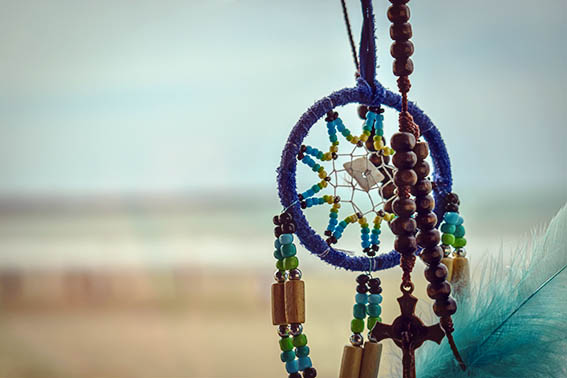
Dream Catcher Meaning
The dream catcher meaning, according to Ojibwe beliefs, is to protect the sleeper from nightmares and negative energies while allowing positive dreams to pass through. It is hung above the bed or sleeping area, where it is believed to catch and filter dreams as they float by during the night.
The use of dream catchers has spread beyond the Ojibwe people and has become popular in mainstream culture, particularly as decorative items or symbols of spiritual protection.
But always recognize and respect the cultural significance and origin of a dream catcher as a Native American tradition. The dream catcher embodies ancient wisdom and respect for nature.
Adorn Your Beautiful Dream Catcher – Personalization and Expression
With a wide variety of designs, sizes, and materials available, a dream catcher offer endless possibilities for personalization and self-expression. From minimalist designs to complex creations adorned with crystals and charms, each dream catcher reflects the unique taste and intention of its creator.
Each element of the dream catcher holds symbolic meaning. The hoop symbolizes unity and the interconnectedness of all life, while the woven web captures negative energies and prevents them from reaching the dreamer. Feathers attached to the bottom of the dream catcher represent breath, air, and the journey of dreams, guiding them safely to the dreamer.
The most common traditionally is to apply Feathers and beads. They have both a symbolic meanings and significance in the Ojibwe culture:
Magic Feathers for Your Protection
Feathers play a significant role in Ojibwe spirituality and cultural practices, serving as powerful symbols of connection, protection, guidance, and respect for the natural world and the spirit realm.
- Spiritual Connection: Feathers are seen as a connection to the spirit world and are often used in ceremonies to communicate with spiritual beings or ancestors.
- Protection: Feathers are believed to provide protection from negative energies and evil spirits. They are often used as talismans or added to objects like a dream catcher to ward off harm and bring blessings.
- Guidance: Feathers are considered symbols of guidance and direction, both in physical and spiritual realms. They may represent the presence of spirit guides or ancestors offering wisdom and support.
- Honoring Nature: Feathers symbolize the interconnectedness of all living beings and the importance of respecting and honoring the natural world. They are often used in traditional clothing and artwork to reflect this connection.
- Sign of Respect: In Ojibwe culture, feathers are given as symbols of honor, respect, and gratitude. They may be gifted during ceremonies or as a gesture of appreciation for acts of kindness or assistance.

Healing Beads – Choose The Right Amazing Color
Beadwork holds great significance in Ojibwe (Chippewa) culture, serving as a form of artistic expression, storytelling, and cultural identity.
Historically, beadwork has been a source of economic sustenance for Ojibwe communities, with beadwork artisans creating intricate pieces for trade or sale. Today, beadwork continues to play a vital role in sustaining cultural practices and supporting indigenous economies.
Beads have been an integral part of Ojibwe traditional clothing, accessories, and ceremonial items for centuries. Here are some of the significances of beads in Ojibwe culture:
- Cultural Identity: Beadwork is a symbol of cultural identity and heritage for the Ojibwe people. Each beadwork design and pattern carries specific meanings and reflects the unique history, beliefs, and experiences of the community.
- Storytelling: Ojibwe beadwork often incorporates intricate designs and motifs that tell stories of creation, nature, spiritual beliefs, and tribal history. The patterns and symbols used in beadwork serve as a form of visual storytelling, passing down cultural knowledge from one generation to the next.
- Spiritual Significance: Beads are sometimes believed to possess spiritual qualities and are used in ceremonial practices and rituals. They may be incorporated into items like dreamcatchers, medicine bags, or ceremonial garments to enhance their spiritual power and significance.
- Healing and Protection: In some Ojibwe traditions, beadwork is believed to have protective and healing properties. Beaded items may be worn or carried as talismans to provide spiritual protection, promote healing, or ward off negative energies.
- Symbolism: Different bead colors, shapes, and patterns hold symbolic meanings in Ojibwe culture. The use of specific colors and designs can convey messages or express specific intentions.

Color Symbolism
These symbolic meanings may vary slightly depending on the specific context and interpretation within Ojibwe culture.
Artisans use beads of various colors, shapes, and patterns to create intricate designs in traditional clothing, artwork, and crafts. Each bead carries its own significance and enhances the overall symbolism of the piece.
- Red: Red beads may represent life, vitality, or the sacred fire.
- Blue: Blue beads may symbolize water or the sky.
- Yellow: Yellow beads may symbolize the sun, warmth, and vitality. They can also represent the dawn of a new day or the cycle of life.
- Green: Green beads often symbolize nature, growth, and renewal. They may represent plants, forests, and the Earth’s abundance.
- White: White beads are associated with purity, clarity, and spirituality. They may symbolize the spirit world, ancestors, or spiritual enlightenment.
- Black: Black beads can symbolize strength, protection, and the unknown. They may also represent night, darkness, and the mysteries of life.
- Purple: Purple beads may symbolize royalty, wisdom, and spirituality. They can represent leadership, honor, and the connection between the physical and spiritual realms.
- Orange: Orange beads are often associated with energy, creativity, and vitality. They may represent the warmth of the sun, enthusiasm, and passion.
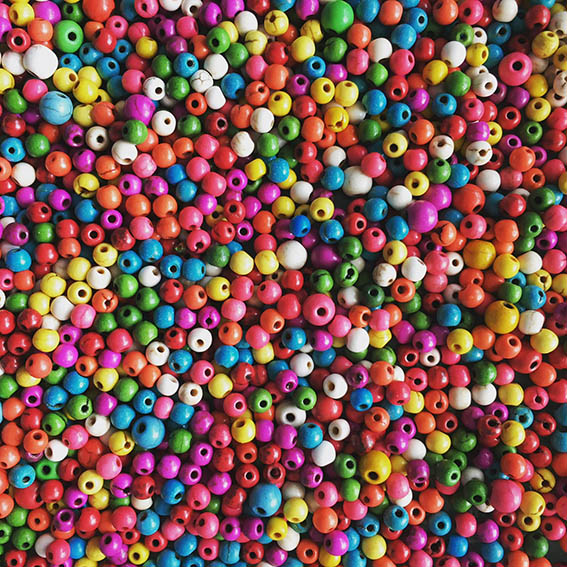
Psycic Protection, Healing and Meditation
In addition to their role in promoting good dreams and warding off nightmares, some individuals use dreamcatchers as tools for healing and meditation. They may hang dreamcatchers in meditation spaces or use them as focal points for relaxation and introspection, incorporating the symbolism of the dreamcatcher into their spiritual practices.
Do Dream Catchers Work
Dream catchers, adorned with intricate webs and symbolic feathers, are believed to protect sleepers from bad dreams. For instance, some have reported fewer nightmares after placing a dream catcher above their bed.
One story comes from a parent whose child had trouble sleeping due to night terrors. They introduced a dream catcher, explaining its purpose to catch bad dreams and let only good dreams pass through. The child felt reassured and soon experienced peaceful nights.
These stories highlight the comfort and sense of security that dream catchers can provide, contributing to a better night’s sleep for many.
But don’t take others’ words for granted. We are all individuals with different experiences. Try for yourself. I wish you sweet dreams 🙂
What does a Dream Catcher Symbolize
A dream catcher symbolizes protection and positive energy. Originating from Native American culture, the web-like design of the dreamcatcher catches bad dreams while allowing good ones to pass through.
The feathers hanging from the dream catcher symbolize air and the breath of life. That is significant as air represents freedom, communication, and the sustaining force of life. Different feathers can also carry specific meanings. For example, owl feathers are often associated with wisdom, while eagle feathers represent courage.
Beads often represent the spider, the web weaver, symbolizing creativity and the intricate work required to weave one’s destiny.
The circle signifies the circle of life. This illustrates how life is interconnected and cyclical, without a clear beginning or end. This reinforces the idea of continuity and the ongoing process of taking away negativity while embracing positivity.
Overall, dream catchers represent the idea of filtering out negativity and embracing positivity. They serve as a reminder to keep one’s dreams and aspirations alive while safeguarding against negative thoughts and energies.
Contemporary Boho Decor Use of a Dream Catcher:
While many associate dreamcatchers with spiritual protection, they also enjoy contemporary boho use beyond their original purpose.Some people use a dream catcher as a decorative element in their home or office believing in the dream catcher´s ability to add a touch of mysticism or beauty to their living space. And to create a peaceful and serene atmosphere.
Additionally, people often give dreamcatchers as gifts to symbolize wishes for good dreams, positive energy, and protection.
While the traditional dreamcatcher features a circular hoop with a woven web and dangling feathers and beads, there’s been a considerable evolution in design over time.
Different tribes and artisans have adapted the design, incorporating various materials, colors, and patterns to reflect their cultural heritage and personal creativity.
Modern dreamcatchers can vary significantly in appearance while still retaining the essence of their purpose.
Dream Catcher in the Modern Decor and Fashion Industry
In fashion industry, and in modern decor, the dream catcher has become popular as decorative items that add a touch of bohemian or spiritual style to living spaces, events, and personal accessories. Whether used as wall decor, fashion accessories, or DIY projects, dreamcatchers continue to captivate people with their symbolic significance and aesthetic appeal.
(Look at the image below. Here, several dream catchers have been assembled into one large decorative wall art. An interesting and creative way to create an individual boho feel.)
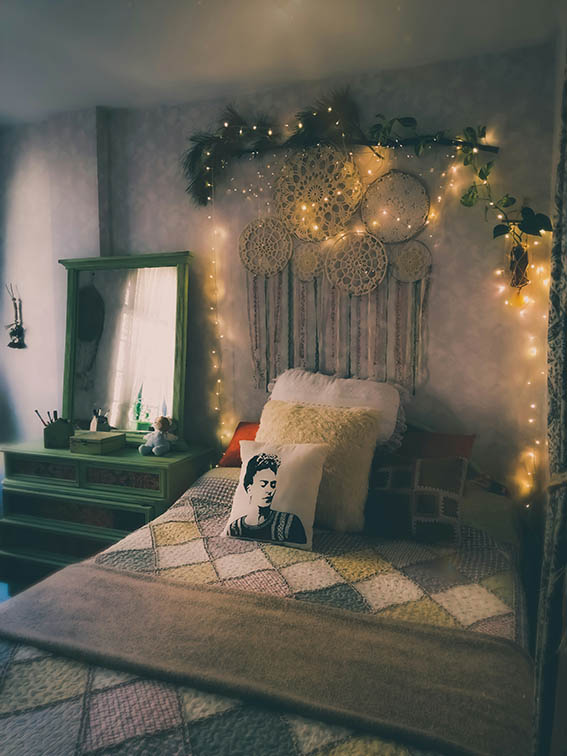
Here’s a breakdown of dream catcher application in contemporary decor and fashion:
Boho Decor for your Home
People commonly use dreamcatchers as wall hangings in their homes, especially in bedrooms, living rooms, and meditation spaces.They add texture, visual interest, and a sense of tranquility to the environment. Modern dreamcatchers often feature a variety of materials, including feathers, beads, macrame, ribbons, and lace, and they come in a range of sizes and designs to suit different decor styles.
Dream catcher in Nursery and Children’s Rooms
Dreamcatchers are also popular choices for decorating nurseries and children’s rooms. They are often hung above cribs or beds to create a calming and dreamy atmosphere. In these spaces, dreamcatchers may feature softer colors and more playful elements, such as whimsical charms or plush decorations, to appeal to young children.
Events and Weddings
Dream catchers have found their way into event decor, including weddings, parties, and festivals. They are used as decorative accents for backdrops, photo booths, centerpieces, and table settings, adding a bohemian or rustic touch to the overall ambiance.
Dreamcatchers can be customized to match specific themes or color schemes, making them versatile decor elements for various occasions.
Fashion Accessories
Beyond decor, dreamcatchers are also incorporated into fashion accessories, such as jewelry and clothing. Earrings, necklaces, bracelets, and anklets adorned with miniature dreamcatchers are popular among those who embrace bohemian or tribal-inspired fashion styles.
From earrings dangling delicately like feathers to statement necklaces featuring intricate web designs. Dream catcher-inspired jewelry adds a touch of whimsy and spirituality to boho outfits.
Additionally, dreamcatcher motifs may appear on clothing items like T-shirts, dresses, and scarves, adding that whimsical and free-spirited vibe to the wearer’s ensemble.
DIY Crafting and Art Projects
Many people enjoy creating their own dreamcatchers as DIY crafting projects or art pieces. DIY kits, tutorials, and workshops are available to guide individuals through the process of making personalized dreamcatchers using various materials and techniques. This hands-on approach allows for creative expression and customization, resulting in unique and meaningful creations.
Dream Catcher Spiritual Tattoos
A dream catcher tattoo is a popular form of body art that draws inspiration from the Native American tradition of dream catchers.
The dream catcher tattoo continue to be a popular choice for those seeking body art with deep spiritual meaning and symbolic significance.
Whether as a symbol of protection, spirituality, or personal expression, the dream catcher tattoo serve as a timeless reminder to follow one’s dreams and embrace the journey of life.
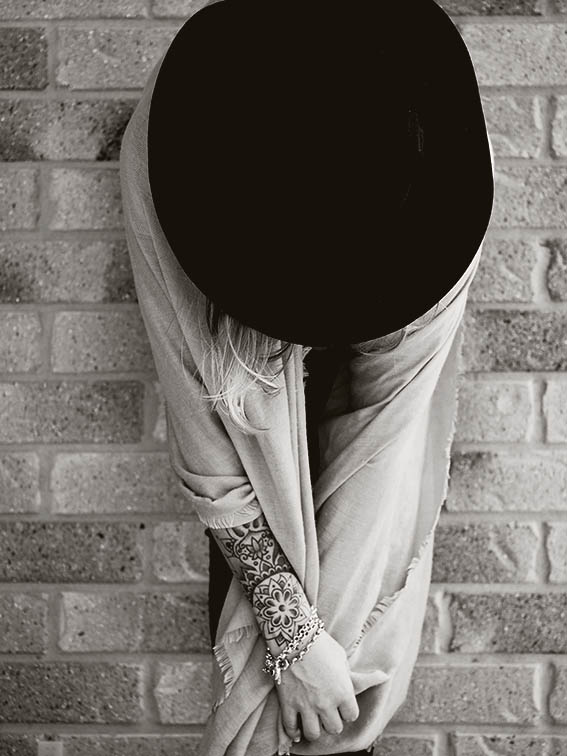
Here’s somethings to know before you choose your dream catcher tattoo:
Dream Catcher Tattoo Meaning and Symbolism:
- Protection: Like traditional dream catchers, dream catcher tattoos are often associated with protection. They are believed to filter out negative energies and nightmares while allowing positive dreams to pass through, providing the wearer with spiritual protection and guidance.
- Spirituality: A Dream catcher tattoo can also symbolize spirituality and connection to the spiritual realm. They may represent the wearer’s beliefs in the power of dreams, intuition, and the interconnectedness of all things.
- Dreams and Aspirations: Dream catcher tattoos often serve as reminders to pursue one’s dreams and aspirations fearlessly. They can represent the wearer’s hopes, desires, and goals, serving as a source of inspiration and motivation.
- Individuality: Like all tattoos, dream catcher tattoos are highly customizable and can be tailored to reflect the wearer’s unique style, personality, and experiences. Each tattoo is a personal expression of the wearer’s identity and values.
Dream Catcher Tattoo Ideas – Design Elements :
Inspired by the bohemian aesthetic, these Boho dream catcher tattoos often feature feathers, beads, and delicate details.
Hoop
The circular hoop is a central element of the dream catcher tattoo, symbolizing unity, wholeness, and the circle of life.
Web
The woven web within the hoop represents the web of life and the interconnectedness of all things. It serves as the primary mechanism for catching and filtering dreams.
Feathers
Feathers are often incorporated into dream catcher tattoos, dangling from the bottom of the hoop, often adorned with decorative accents like beads, charms, or tassels for a bohemian touch. They symbolize breath, air, and the journey of dreams, guiding positive dreams to the dreamer.
Beads
Beads are sometimes added to dream catcher tattoos for decorative purposes. Integrate colorful beads throughout the dream catcher design, incorporating different shapes, sizes, and textures to create visual interest and depth.They may represent different aspects of the wearer’s life, such as love, family, or spirituality.
Floral Accents
Include floral motifs and botanical elements intertwined with the dream catcher design, such as blooming flowers, leaves, or vines, to enhance its boho chic aesthetic.
Moon and Stars
Incorporate celestial symbols like the moon, stars, or sunbursts into the dream catcher tattoo to evoke a sense of magic, mystery, and cosmic energy.
Arrows
Include arrow motifs, which symbolize direction, protection, and spiritual guidance, intertwined with the dream catcher design to add depth and symbolism.
Script or Quotes
Incorporate meaningful quotes, mantras, or script elements into the dream catcher design, adding a personal touch and further enhancing its boho chic vibe.
Personalized Symbols
Include personalized symbols or elements that hold special significance to the wearer, such as initials, birthstones, or symbols representing specific intentions or aspirations.
By combining these design elements, you can create a unique and captivating dream catcher tattoo inspired by the boho chic style, tailored to reflect your individuality and spiritual journey.
Tattoo Placement and Variations:
- Placement: Dream catcher tattoos can be placed on various parts of the body, including the back, shoulder, arm, thigh, or ankle. The placement often depends on personal preference and the size of the tattoo.
- Variations: While traditional dream catcher tattoos feature classic designs, there are endless variations and interpretations available. Some people opt for intricate, detailed tattoos with vibrant colors and elaborate patterns, while others prefer simpler, minimalist designs.

Cultural Considerations:
- Cultural Sensitivity: It’s important to approach dream catcher tattoos with cultural sensitivity and respect for their Native American origins. Educating oneself about the cultural significance of dream catchers and consulting with Indigenous artists or cultural advisors can help ensure that the tattoo is done thoughtfully and responsibly.
- Appropriation Concerns: Some Indigenous communities have expressed concerns about the appropriation of dream catchers and other sacred symbols. When getting a dream catcher tattoo, it’s essential to be mindful of its cultural significance and avoid appropriating sacred symbols or practices from Native American cultures.
Dream Catcher trapping negative dreams
In traditional Ojibwe culture, dreamcatchers were typically hung above the bed or sleeping area, where they could catch and filter dreams as they floated by during the night. Some interpretations suggest that hanging a dream catcher in the east direction can be particularly meaningful. The east is often associated with the rising sun, new beginnings, and the dawn of a new day. Symbolizing hope, renewal, and positive energy.
They were often placed near the head of the bed or suspended from the ceiling, allowing them to fulfill their intended purpose of trapping negative dreams and allowing positive ones to pass through.
The specific placement could vary depending on individual preferences or beliefs within the family or community.

Adaptation of Dream Catcher like items in Other Culturese
While the dream catcher is commonly associated with Native American culture, similar items can be found in other cultures around the world. Items resembling the dream catcher are used for similar purposes of protection and filtering dreams.
Here are a few examples of similar items and their cultural significance:
- Central and South American Indigenous Cultures: Some Indigenous communities in Central and South America have their own versions of dream catcher -like objects. These items may have different names and designs but serve similar purposes of protecting sleepers from negative energies and nightmares while allowing positive dreams to pass through. For example, among the Huichol people of Mexico, there are “ojo de dios” (eye of God) weavings, which are often made with colorful yarn and have a central eye-like pattern.
- Australian Aboriginal Culture: In Australian Aboriginal culture, “bush toys” or “bush dreamers” are sometimes made by weaving materials like twigs and feathers into circular shapes resembling dreamcatchers. These objects are often used by Aboriginal elders to teach children about their culture, spirituality, and the significance of dreams.
- Siberian Indigenous Peoples: Some Indigenous groups in Siberia, such as the Evenki and Yakut people, have traditions involving objects similar to dreamcatchers. These items, known as “tungas,” are often made with materials like birch bark, feathers, and animal bones, and they are believed to protect against evil spirits and ensure good dreams.
- African Cultures: While not identical to dreamcatchers, some African cultures have traditions involving charms or talismans placed near sleeping areas to ward off negative energies and promote positive dreams. These objects may incorporate feathers, beads, and other materials, reflecting the cultural significance of dreams and their interpretation.

DIY Boho Decor: Crafing a Dream Catcher
DIY dream catcher kits and tutorials, allowing individuals to experiment with different materials and techniques to make unique pieces has become a popular craft activity, with many people enjoying the process of creating their own personalized designs, and explore the beauty of creativity and self-expression.
How to Make a Dream Catcher
Here’s a step-by-step guide to making your own dreamcatcher:
Materials Needed:
- Hoop (traditional materials include willow branches or metal rings)
- String, yarn, or waxed cord
- Feathers
- Beads
- Scissors
- Glue (optional)
- Decorative elements like ribbons, lace, or charms (optional)
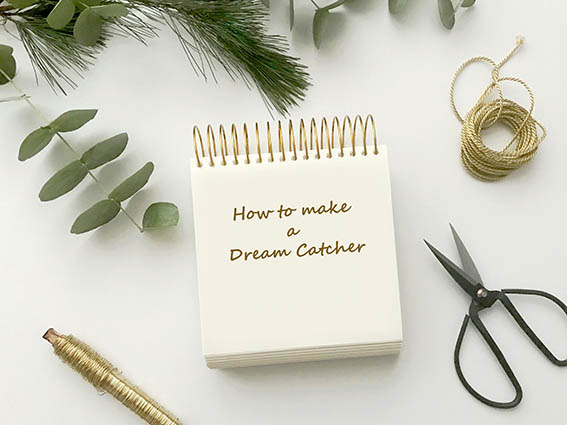
Instructions:
1. Prepare the Hoop
- If you’re using a metal ring, you can skip this step. If using willow branches or similar materials, bend them into a circular shape and secure the ends together using string or glue. Trim any excess branches.
2. Create the Web
- Start by tying the string or yarn to the hoop. You can tie it anywhere on the hoop.
- Make a loop with the string and pull it through the hoop, creating a basic knot. This will serve as the starting point for the web.
- Continue making loops around the hoop, spacing them evenly apart. As you go around, pull each loop tightly to create tension in the web.
- Continue weaving the string in a circular pattern, gradually moving toward the center of the hoop. You can add more loops or layers for a denser web, or keep it sparse for a more open design.
- Once you reach the center of the hoop or are satisfied with the size of the web, tie off the string and trim any excess.
3. Attach Feathers and Beads for a Boho Feel
- Cut several pieces of string or yarn to your desired length for hanging feathers and beads.
- Thread a bead onto each piece of string, followed by a feather. You can add multiple beads and feathers to each string for a layered look.
- Tie the strings with beads and feathers onto the bottom of the dreamcatcher hoop. Space them evenly around the circumference of the hoop, or concentrate them in one area for a clustered effect.
- You can also add additional decorations like ribbons, lace, or charms to the hoop or hanging strings for extra embellishment.
4. Finishing Touches
- Once you’ve attached all the feathers, beads, and other decorations, give your dreamcatcher a final inspection to make sure everything is secure.
- Trim any excess string or yarn.
- If desired, you can add a loop of string or ribbon to the top of the dreamcatcher for hanging.
5. Display Your Dream Catcher
- Hang your finished dreamcatcher above your bed, in a window, or anywhere else you’d like to enjoy its beauty and symbolic significance.
- Enjoy the process of catching dreams and adding a personal touch to your space with your handmade creation!
Feel free to personalize your dream catcher by experimenting with different materials, colors, and designs. Let your creativity guide you as you make a unique piece that reflects your style and personality. Happy crafting!

Additional Tips and Information:
Crafted in various sizes, shapes, and colors, dreamcatchers offer endless possibilities for self-expression. From minimalist designs to elaborate creations adorned with crystals and shells, each dreamcatcher reflects the unique aesthetic and personality of its creator.
1. Choose Meaningful Materials
Consider the symbolism and significance of the materials you use. For example, feathers can represent spirituality and freedom, while beads may symbolize protection and unity. Select colors and textures that resonate with you or hold personal meaning.
2. Traditional vs. Modern Design
While traditional dreamcatchers feature a circular hoop with a woven web, feel free to experiment with different shapes and patterns. Try using non-traditional materials like embroidery hoops, metal wire, or even driftwood for a unique twist on the classic design.
3. Mindful Crafting Boho Decor
Crafting a dreamcatcher can be a meditative and mindful process. Take your time and focus on each step, allowing yourself to be fully present in the moment. Let your intuition guide you as you create, and infuse your intentions and positive energy into the finished piece.
4. Ecological Considerations Building a Dream Catcher
If using natural materials like feathers or branches, consider their ecological impact and sustainability. Opt for ethically sourced or reclaimed materials whenever possible, and avoid using feathers from protected bird species. You can also explore alternatives like faux feathers or recycled beads for an eco-friendly approach.
5. Cultural Sensitivity
While crafting dreamcatchers can be a fun and creative activity, it’s essential to be respectful of the cultural origins and significance of these objects. Educate yourself about the traditions and beliefs associated with the dream catcher, and study sacred symbols and practices from Indigenous cultures, to know if it is ok to use them.
6. Sharing the Craft
Consider hosting a dream catcher-making workshop or crafting session with friends and family. It can be a wonderful opportunity to connect with others, share creative skills, and learn from each other’s unique perspectives. Encourage each participant to infuse their dreamcatcher with their own intentions and dreams.
7. Dream Catcher Maintenance
Over time, dust and debris may accumulate on your dream catcher. To keep it clean and well-maintained, gently dust it with a soft brush or cloth periodically. Avoid exposing it to direct sunlight for prolonged periods, as this can cause fading or damage to the materials.
8. Give Someone You Like a Dream Catcher as a Gift
Handcrafted dreamcatchers make thoughtful and meaningful gifts for loved ones. Consider making personalized dreamcatchers for birthdays, weddings, or other special occasions, incorporating elements that hold significance for the recipient. Your handmade creation is sure to be cherished as a symbol of love, protection, and dreams fulfilled.
Crafting your own dream catcher is not only a creative process but also an opportunity for self-expression, mindfulness, and connection with ancient traditions. Embrace the process, trust your intuition, and let your imagination soar as you bring your dreamcatcher to life.
May it inspire sweet dreams, positive energies, and endless possibilities!

Dream Catcher Catches the Boho spirit
Beyond their aesthetic appeal, dream catchers hold deeper meanings in boho society. They serve as reminders to live authentically, embrace creativity, and follow one’s dreams fearlessly.
Dream catchers offer a sense of solace and hope, inviting individuals to tap into their inner wisdom and intuition.
In essence, a dream catcher embody the essence of bohemianism – freedom, individuality, and connection to nature and spirituality.
As timeless symbols of peace and creativity, the dream catcher continue to inspire and captivate boho souls around the world, and weaving your dreams into reality one delicate thread at a time.
